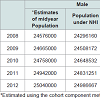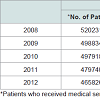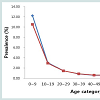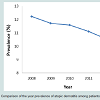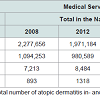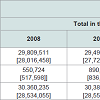Journal of Clinical and Investigative Dermatology
Download PDF
Research Article
*Address for Correspondence:Jung-Im N, Department of Dermatology, Seoul National University College of Medicine, Seoul National University Bundang Hospital, 300 Gumi-dong, Bundang-gu, Seongnam-si, Gyeonggi-do, 463-707, Korea, Tel: +82-31-787- 7314; Fax: +82-31-787-4058; E-mail: vividna@gmail.com
Citation: Na SY, Choi JW, Shin JW, Park KC, Huh CH, et al. Recent Statistics on Atopic Dermatitis in Korea: Five-Year Nationwide Analysis from 2008 to 2012. J Clin Investigat Dermatol. 2014;2(2): 4.
Copyright © 2014 Na et al. This is an open access article distributed under the Creative Commons Attribution License, which permits unrestricted use,distribution, and reproduction in any medium, provided the original work is properly cited.
Journal of Clinical & Investigative Dermatology | ISSN 2373-1044 | Volume: 2, Issue: 2
Submission: 04 February 2014 | Accepted: 14 March 2014 | Published: 19 March 2014
Reviewed & Approved by: Dr. Claudia I. Vidal, Assistant Professor in the Department of Dermatology and a board certified pathologist and dermatopathologist at Saint Louis University, USA.
Recent Statistics on Atopic Dermatitis in Korea: Five-Year Nationwide Analysis from 2008 to 2012
Se-Young Na1, Jee-Woong Choi2, Jung-Won Shin1, Kyung-Chan Park1, Chang-Hoon Huh1 and Jung-Im Na1*
- 1Department of Dermatology, Seoul National University Bundang Hospital, Republic of Korea
- 2Public Health Care Center in Danyang, Ministry of Health and Welfare, Republic of Korea
*Address for Correspondence:Jung-Im N, Department of Dermatology, Seoul National University College of Medicine, Seoul National University Bundang Hospital, 300 Gumi-dong, Bundang-gu, Seongnam-si, Gyeonggi-do, 463-707, Korea, Tel: +82-31-787- 7314; Fax: +82-31-787-4058; E-mail: vividna@gmail.com
Citation: Na SY, Choi JW, Shin JW, Park KC, Huh CH, et al. Recent Statistics on Atopic Dermatitis in Korea: Five-Year Nationwide Analysis from 2008 to 2012. J Clin Investigat Dermatol. 2014;2(2): 4.
Copyright © 2014 Na et al. This is an open access article distributed under the Creative Commons Attribution License, which permits unrestricted use,distribution, and reproduction in any medium, provided the original work is properly cited.
Journal of Clinical & Investigative Dermatology | ISSN 2373-1044 | Volume: 2, Issue: 2
Submission: 04 February 2014 | Accepted: 14 March 2014 | Published: 19 March 2014
Reviewed & Approved by: Dr. Claudia I. Vidal, Assistant Professor in the Department of Dermatology and a board certified pathologist and dermatopathologist at Saint Louis University, USA.
Abstract
Background: Most of the previous epidemiologic studies on atopic dermatitis were based on the analysis of young patients excluding adults, and the target population was confined to a certain area. Korea has a national health insurance system, which covers the entire population and all medical facilities. Details of every medication, medical service, and diagnosis can be obtained in the Korean health insurance database.Objectives: The goal of this study was to obtain recent statistics on atopic dermatitis in Korea.
Material and Methods: The Health Insurance Review and Assessment Service, a national medical database covering the entire Korean population, was analyzed. The prevalence, total cost, day of hospitalization, and the number of office visits during the most recent 5 years (2008-2012) were evaluated annually and compared.
Results: The 12-month prevalence of atopic dermatitis decreased from 2.27% in 2008 to 1.98% in 2012. The prevalence of atopic dermatitis also showed a gradual decrease from 2008 (12.23%) to 2012 (10.51%). The number of hospital-admitted patients for AD increased by 47.6%, however, the mean admission days per inpatient decreased from 8.08 in 2008 to 6.44. The overall costs related to atopic dermatitis remained unchanged.
Conclusions: The prevalence of atopic dermatitis is now decreasing in Korea.
Keywords
Atopic dermatitis; Hospitalization; National health insurance; Medical cost; PrevalenceIntroduction
Atopic dermatitis (AD) is an itchy, chronic or chronically relapsing, inflammatory skin disease that is commonly associated with other atopic conditions such as asthma or allergic rhinitis in individuals or other family members. Although AD is a common condition, accurate assessment of its prevalence is complicated because of the different assessment methods used. The International Study of Asthma and Allergies in Childhood (ISAAC) is an representative epidemiologic study that uses cross-sectional questionnaires to assess children aged 6-7 years and 13-14 years in 56 centers throughout the world. The ISAAC program has allowed worldwide assessment of the prevalence of self-reported symptoms of asthma, allergic rhinoconjunctivitis, and atopic eczema in children using standard methods [1]. However, the use of self-reported questionnaires may have drawbacks such as validity problems.Previous studies suggest that the prevalence of atopic diseases has increased substantially over recent years [,3]. Several reports indicate that the increase has slowed or ceased, and some have even reported a decreasing prevalence [4,5]. Most of those earlier epidemiologic studies analyzed young patients, not adults, and the target population was confined to a certain area.
Korea has a national health insurance system, which covers the entire population and all medical facilities including hospitals, community clinics, public health centers, and even Chinese medicine clinics. Therefore, the Korean health insurance database includes details of every medication, medical service, and diagnosis. Almost all medical costs related to AD treatment, which include fee for outpatient consultation, hospitalization, procedure and medication, are covered by national health insurance. In this study, the authors conducted a retrospective analysis of a national database covering the entire Korean population. The study population comprised all national health-insured persons. The prevalence, total costs, days of hospitalization, and the number of office visits were evaluated annually and compared.
Materials and Methods
Data sourcesThe Health Insurance Review and Assessment Service (HIRA), organized in 1989, conducts reviews and assessment of medical fees in Korea. The reimbursement process starts with the health institution filing a claim with HIRA for medical fees. Accordingly, the HIRA database contains reimbursement records from all medical facilities. Since 2002, hospitals and clinics have been required to electronically file the patient-visit records to the HIRA, and such data are accessible to the public. The HIRA dataset includes information on age, sex, primary diagnosis (based on the International Classification of Diseases and Related Health Problems, ICD-10), all medical costs, duration of stay, and the number of outpatient visits. All medical costs related to AD including laboratory examinations, medications, and hospitalization are covered by National Health Insurance (NHI), and all associated records are saved in the HIRA databases. Therefore, we used the insurance claim records collected by the HIRA.
Study population
The Korean health insurance system is based on an obligatory NHI scheme, which requires all citizens to join the NHI scheme. Thus, the study population was defined as citizens who were subscribers to the NHI from 2008 through 2012. Annual claim records were aggregated. More than 99% of the estimated population was covered by NHI in 2012 (Table 1).
Patients were considered to have AD when a diagnostic code for AD was registered with HIRA. We identified insured persons who had at least one NHI claim record with a primary diagnosis of AD. The diagnostic codes of ICD-10 for AD (L20*) were included in the current study.
Estimation of prevalence and medical costs
The total number of individuals with health insurance was used as the denominator for estimating prevalence. In each year from 2008 to 2012, the number of insured persons very closely approximates the estimated population as previously mentioned. Therefore, we assumed that the prevalence of the insured was representative of the prevalence of the entire population in Korea. We also divided the age of the subjects into 10-year age categories. For each year, we calculated the age-specific prevalence of AD by dividing the total number of patients with AD by the total size of the population under NHI of that particular age based on the National Health Insurance Statistical Yearbook [6].
The medical cost of AD per patient was calculated by adding the costs of hospital visits, prescription costs, and cost of referrals to a dermatologist or laboratory. For general comparison, estimates of the medical costs were converted into US dollars.
Results
PrevalenceThe 12-month prevalence of AD, obtained from a number of patients who received medical services at least once a year under the primary diagnosis of AD, decreased from 2.27% in 2008 to 1.98% in 2012. The denominator was the total number of insured individuals. Sex-specific prevalence was slightly higher in women than in men during 2008-2012 (Table 2). The age-specific prevalence curve is L-shaped, and the prevalence was highest in those in the first year (Figure 1). No significant difference is noted between two curves (2008 and 2012), except for a higher prevalence in the year 2008 curve. The prevalence of AD among 0-9 years of age showed a gradual decrease from 2008 (12.23%) to 2012 (10.51%) (Figure 2).
Both the total number of outpatients and the number of outpatient visits decreased in the most recent 5 years. The mean number of hospital visits per capita also decreased from 2.08 in 2008 to 2.01 in 2012. In contrast, the number of inpatients and total hospital admission days showed a remarkable increase. The number of hospital-admitted patients for AD increased by 47.6%, and the total number of hospital admission days for AD also increased by 17.6%. However, the mean admission days per inpatient decreased from 8.08 in 2008 to 6.44 in 2012 (Table 3).
Despite decreasing prevalence, the overall costs of AD remain unchanged. Medical costs for inpatients increased, whereas costs for outpatients slightly decreased. Annual costs per patient attributable to AD also did not change considerably. Total annual costs per patient showed only a slight increase, from 27,740 won (26.07$) in 2008 to 30,970 won (29.11$) in 2012 (Table 4).
Discussion
Our study is the nationwide survey including the entire Korean population. The results of our study indicate that the prevalence of AD in Korea is decreasing. Korea experienced a rapid increase of allergic disease during the past several decades with industrialization. The ISAAC study phase I and III results showed that the prevalence of eczema in Korea had increased during 1995-2000. The eczema prevalence in the 6-7 year age group increased from 8.8% in 1995 to 11.3% in 2000. The 13-14 year age group also showed an increased prevalence from 3.8% to 5.7% [2]. However, recent study results suggest that the trend has changed. The prevalence study performed in 2005 and 2008 showed that the overall prevalence of AD in Korea began to decrease from 2.33% in 2005 and 2.18% in 2008 [7]. The current study demonstrates that the prevalence continues to decrease; it was 2.17% in 2008 and 1.98% in 2012. This means the prevalence of AD in Korea is decreasing in the most recent 10 years. Although the cause of the decrease is unclear, public education about AD might be beneficial. A high prevalence of AD revealed by a nationwide ISAAC study was brought to the Korean people’s attention. With the help of mass media and education offered by healthcare providers, parents became aware of the risks and protective factors of AD. The breastfeeding rate in Korea shows the effect of this education on Korean individuals. The rate for exclusive breastfeeding declined from 1994 to 2000; however, it increased thereafter and almost tripled in 2009 [8]. The protective effect of exclusive breastfeeding on allergic disease had been widely advertised and resulted in the change.Despite the decreased prevalence, the number of hospitaladmitted patients and total number of hospital admission days for AD showed a remarkable increase during 2008-2012. The increase in hospital admissions cannot be solely explained by an increase in patients with severe AD. Mean hospital admission days per patient decreased during 2008-2012, and the total medical costs for AD showed only a modest increase. Increased sales of private medical expense insurance in Korea might have contributed to increased hospital admissions. In Korea, 40~100% of the whole medical cost is deductible with NHI and the rest of it is copayment. As private medical expense insurance covers up copayment, patients who also have private insurance can use medical service for virtually free, which leads to the increased medical service utilization. According to NHI data, the total number of hospital admission days for all diseases increased by 32% during 2008-2012. The total medical costs for all diseases per capita also rose by 34% during the 5 years. In comparison, the medical costs for AD showed a relatively small increase. Annual medical costs per patient increased by 11.6% during 2008-2012.
Our study has several limitations. Because our study is hospitalbased, the results can differ from community-based data. Our study can reflect only insured medical costs for AD. However, with this study we could survey the overall trend of AD in the entire Korean population. Our study shows that the prevalence of AD in Korea is decreasing.
References
- The International Study of Asthma and Allergies in Childhood (ISAAC) Steering Committee (1998) Worldwide variation in prevalence of symptoms of asthma, allergic rhinoconjunctivitis, and atopic eczema: ISAAC. Lancet 351: 1225-1232.
- Asher MI, Montefort S, Bjorksten B, Lai CK, Strachan DP, et al. (2006) Worldwide time trends in the prevalence of symptoms of asthma, allergic rhinoconjunctivitis, and eczema in childhood: ISAAC Phases One and Three repeat multicountry cross-sectional surveys. Lancet 368: 733-743.
- Grize L, Gassner M, Wuthrich B, Bringolf-Isler B, Takken-Sahli K, et al. (2006) Trends in prevalence of asthma, allergic rhinitis and atopic dermatitis in 5-7-year old Swiss children from 1992 to 2001. Allergy 61: 556-562.
- Toelle BG, Ng K, Belousova E, Salome CM, Peat JK, et al. (2004) Prevalence of asthma and allergy in schoolchildren in Belmont, Australia: three cross sectional surveys over 20 years. BMJ 328: 386-387.
- Lee YL, Li CW, Sung FC, Guo YL (2007) Increasing prevalence of atopic eczema in Taiwanese adolescents from 1995 to 2001. Clin Exp Allergy 37: 543-551.
- Korean population statistics.
- Seong HU CS, Park SY, Yang JM, Lim DH, Kim JH, et al. (2012) Nationwide survey on the prevalence of allergic diseases according to region and age. Pediatr Allergy Respir Dis 22: 224-231.
- Chung SH, Kim HR, Choi YS, Bae CW (2013) Trends of breastfeeding rate in Korea (1994-2012): comparison with OECD and other countries. J Korean Med Sci 28: 1573-1580.


